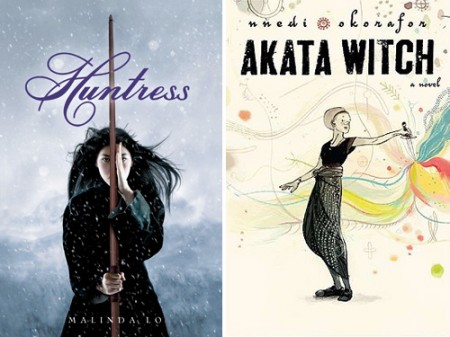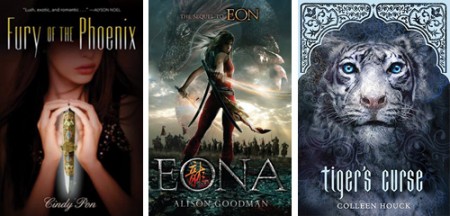Don't judge a book by its cover
Today over at the Enchanted Inkpot, I posted a piece about cover trends in this winter's crop of YA fantasy novels. Several commenters immediately noted that they saw a lack of people of color on the book covers, and expressed a desire for more diversity. My reaction is sorta complicated, and since whitewashing YA covers continues to be discussed in the YA book community, I wanted to share some of my thoughts about this. (Warning: this is a looong post!)
From January to April 2011, I counted 57 young adult fantasy novels being published by all the major American book publishers. Among those 57, nine include main or major supporting characters of color:
Akata Witch by Nnedi Okorafor Dark Goddess by Sarwat Chadda Eona by Alison Goodman Fury of the Phoenix by Cindy Pon Huntress by Malinda Lo Iron Witch by Karen Mahoney Red Glove by Holly Black Slice of Cherry by Dia Reeves Tiger's Curse by Collen Houck
Three include main or major supporting gay characters:
City of Fallen Angels by Cassandra Clare Huntress by Malinda Lo Shadow Walkers by Brent Hartinger
So, that's 11 books that incorporate racial and/or sexual diversity. That's 19% of YA fantasy novels being published from January-April 2011. I think that's actually quite an astonishing percentage.
Among those 11 books, two are represented by covers that clearly feature people of color:

Another three include distinct Asian elements that echo the books' Asian inspirations:

(It is harder to tell in this small images, but the dagger on Fury of the Phoenix is engraved with a Chinese character. There is a Chinese character on the cover of Eona. And those curlicues on Tiger's Curse look quite South Asian to me.)
A lot of commentary laments the low percentage of books with people of color on the covers (and yes, it is low), especially in comparison to the huge number of YA novels (fantasy and otherwise) featuring slim, attractive white girls. I totally get that. And yet, there are a few things that I think is important to remember.
Book covers are advertisements. This doesn't mean that they can get away with just anything to sell a book to teens (because if that were the case, hello, freaking Robert Pattinson would be on the cover of every YA novel), but it does mean that cover designers are working within a marketing context.
Before you get upset and say, "But I am a consumer who wants to see more diversity! I would buy books with people of color on them!" — I assure you that I'm not talking about you. Readers who visit my website are already engaged in the dialogue online about race and representation in YA fiction (or they've read my book — hi, readers of my book! — and they know what I'm about). I'm talking about the mass market for YA books; teens who pick up a book because of its cover at Barnes & Noble or their local/school library.
Do I think that these "mass market" teen readers are racist? No. But they, like everybody else on the planet, is part of a world dominated by an entertainment industry (and society, too) that sells whiteness as attractive and desirable. Yes, I wish that were not the case, but you can't ignore reality.
The reality is: At this point in time, slim, attractive white girls sell books. They sell freaking everything. Just look at an issue of People sometime, or turn on your TV. What do you see? Slim, attractive white girls.
This doesn't mean that it's OK to always slap a white girl on a YA book cover. But in order to change the status quo (which I believe is already changing), you have to do some sneaky manipulation in order to get the ordinary, non-YA-blogosphere reader to pick up a book about someone who is different from them. Sometimes that does mean putting a dust jacket on a book that does not shout out "HEY I'M TOTALLY DIFFERENT FROM YOU!"
(Obviously, this scenario is different if you are a person of color yourself. Hang on a sec — I'll address that a little further down in this post.)
The only job of a book cover, in my opinion, is to get someone to pick up a book and read the flap copy or the first page. Hopefully then the words will complete the sale.
And that's the important thing: the words. The most important part of a book is always the words of the story; it is never the cover. There are good covers and there are bad covers, but most often, there are mediocre covers. No cover will ever perfectly match an author's vision for her book, and no cover will ever attract every reader. That's why it is so important to look beyond the cover, in all cases.
That maxim of "don't judge a book by its cover"? Well, it's still true. Even if a book cover doesn't echo the diversity within the book, that doesn't erase the diversity. It hides it a little, yes, but the cover is not the story. The cover is an advertisement. (And in most cases, it's removable.)
Every time someone reads a book about a character who is different from them — even if they didn't know it going into it — that reader's universe is broadened a little. This is how the status quo is going to change: publishing more books about diverse characters, and giving them covers that attract readers. As more of them sell, publishers will be more inclined to incorporate diversity overtly on the covers. (I'm being optimistic, but I actually do believe this.)
If you're a person of color and you are sick of not seeing yourself represented on book covers, I get it, even though I don't personally fret so much about not seeing Asian women on book covers (I do get a bit frustrated by Hollywood, though). I tend to be more annoyed by overly exoticized representations of "Asianness."
But the reason I understand your frustration is because I've been following the representation of lesbians in the media for years. It is so hard to find a realistic, three-dimensional lesbian character in television or film. YA fiction actually is doing fairly well in this area, though it publishes far more books about gay boys than lesbian girls.
One way book publishers (both YA and adult) sell books that include queer characters is by hiding the queerness in the jacket copy — essentially by closeting the gay story lines. This happens all the time. I recently read Kate Morton's The Distant Hours, a recent major women's fiction commercial release, not suspecting it had a lesbian character at all, but it did.
This has also happened to my own first novel, Ash. The U.S. edition doesn't entirely hide the gayness, but the jacket copy is, at best, suggestive. The U.K. edition, however, totally closets the gay story line. Here's the U.K. jacket copy:
With her parents both gone, Ash finds herself a servant in the house of her ruthless stepmother and there seems no hope of finding happiness again.
But Ash is unaware of her mother's legacy, and that it will lead her to a magical place. A place where love, identity and belonging are all waiting....
There are no blurbs on the cover from any authors who have written about gay teens (often a hint about gay content). There are no review quotes that mention the gay stuff. There's not even a suggestive excerpt on the back, like on the American edition. Along with the obviously Cinderella image, the book seems totally straight.
The U.S. version of Ash has sold well. The U.K. edition has sold even better.
Partly, I think this has to do with distribution. In the U.K., Ash was available in bookstores, but it was also available at Asda, which is the U.K. equivalent of Wal-Mart. (In the U.S., it was definitely not available at Wal-Mart.) But I also do think it's partly due to the heterosexual-seeming packaging.
I often get emails from readers in the U.K. saying, "I had no idea this book would turn out to be about a lesbian relationship, but I loved it anyway." These kinds of comments make me both happy and a little sad. Happy because they loved the story enough to write to me, obviously! But a little sad because it implies that had they known it was a lesbian story, they wouldn't have read it.
Many people still believe that books about people of color or LGBT people are only for readers who are also people of color or LGBT. This is a sad but incontrovertible truth. We can't ignore this. Those of us who write books about people of color or LGBT people have to acknowledge it. And until the world changes — and every time another diverse book is published, regardless of the cover or the cover copy, that change happens — sometimes it's necessary to market to the masses.
Taking to the streets (even figuratively) and shouting about the need for equality is something that needs to be done, and is being done by many people today.
But change can also happen subversively. Subversiveness is just another tool we can use, successfully, to make the world a more inclusive place.